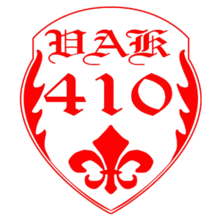VAK410

The VAK410 (Dutch, "Gate 410") is a Dutch Ultras group associated with AFC Ajax. The name is from the stand in Ajax's home stadium Amsterdam Arena.[1][2]
Background
VAK410 was founded on 26 January 2001 by hardcore supporters of the club who were tired of being on the waiting list to join the existing hooligan firm F-side. On that day, young Ajacied Karel organized the first meeting of the group in the Amstel Cup home match against SBV Vitesse in row 114. The match ended in a 1–2 loss. However, the club took a positive stance towards the initiative to create more atmosphere in the North side of the stadium and VAK410 was born.[3]
Originally known as the Ajax Ultras with ajaxultras.nl being the official website, the group relocated to row 415 on 11 February 2001 ahead of the home match against Willem II, right next to the "Away row" for the visiting supporters. Ajax fanzine De Ajax Ster otherwise known as DAS reported on the development of the row, despite the low turnout of the ultras during the match. Two weeks later, on 25 February 2001, a big success was celebrated, however, when a large gathering managed to silence the visiting crowd during the home match against FC Utrecht.[4]
The first match in their current location in the stadium, after which they took the name VAK410, was on 19 August 2001 in a home match against Roda JC, at which point the group had approximately 400 members. Considered one of the most famous Tifosi groups in the sport, the group consider themselves ultras and distance themselves from association with football hooliganism .[5]
Incidents
Since the formation of the group there have been several incidents that have occurred which have drawn negative press, and that have led to the club being fined. In August 2010, Ajax was fined €10,000 for the group's behavior during an away UEFA Europa League away match against Juventus, due to severe destruction in the stadium, the lighting of fireworks and for injuring an Italian steward of the stadium.[6] Ajax was fined €10,000 once more in 2013 during the UEFA Champions League home match against Manchester City after VAK410 revealed a massive banner showing a crossed out Sheikh holding a bag of money, with the words "Against Modern Football!" below it. UEFA called the banner tasteless and completely unfitting after issuing the fine.[7][8] During the final for the KNVB Cup in 2014, the group sabotaged the match by throwing fireworks onto the pitch in the vicinity of their own goalkeeper. They did this because the final was played at 'De Kuip' and that is the stadium of the rival 'Feyenoord Rotterdam'. The match was stopped twice with Ajax leading 1–0. After resumption of the Match Ajax eventually lost 1–5 to PEC Zwolle. The group at first stated that throwing fireworks is an inalienable part of such finals.[9] After pressure from authorities and the F-side, the group eventually did apologise for its behaviour in what would be known as the Vuurwerkincident.[10]
Judaism
Ajax is popularly seen as having "Jewish roots" and in the 1970s supporters of rival teams began taunting Ajax fans by calling them Jews. Ajax fans (few of whom are actually Jewish) responded by embracing Ajax's "Jewish" identity: calling themselves "super Jews", chanting "Joden, Joden"" (Jews, Jews) at games, and adopting Jewish symbols such as the Star of David and the Israeli flag. This Jewish imagery eventually became a central part of Ajax fans' culture. At one point ringtones of "Hava Nagila", a Hebrew folk song, could be downloaded from the club's official website. Beginning in the 1980s, fans of Ajax's rivals escalated their antisemitic rhetoric, chanting slogans like "Hamas, Hamas/Jews to the gas" ("Hamas, hamas, joden aan het gas"), hissing to imitate the flow of gas, giving Nazi salutes, etc. The eventual result was that many (genuinely) Jewish Ajax fans stopped going to games. In the 2000s the club began trying to persuade fans to drop their Jewish image, yet have achieved no success in this pursuit. Supporters, on and off the field, still employ imagery associated with Jewish history and the Israeli nation. Tottenham Hotspur's Yid Army use similar symbols.[11][12][13]
See also
- North Up Alliance
- South Crew
- Barra Brava
- Casuals
- Curva
- Hooliganism
- List of hooligan firms
- Major football rivalries
- Torcida
References
- ↑ "YouTube - VAK410: een vak apart". youtube.com. Retrieved 2014-04-06.
- ↑ "VAK410: een vak apart - YouTube". youtube.com. Retrieved 2014-04-06.
- ↑ Vak410 anno 2001
- ↑ Ajax bestraft vak 410 na afsteken vuurwerk
- ↑ Vak 410 van Ajax verhuist naar zuidzijde
- ↑ UEFA legt Ajax boete op
- ↑ Foto: Uefa beboet Ajax voor anti-sjeikspandoek
- ↑ Vak 410 zegt sorry tegen Ajax-fans
- ↑ "RTV NH - Sport - 'Vuurwerk hoort bij bekerfinale'". rtvnh.nl. Retrieved 2014-06-28.
- ↑ "Elsevier.nl - Fanatieke Ajax-aanhang zegt sorry tegen spelers en harde kern". elsevier.nl. Retrieved 2014-06-28.
- ↑ Amsterdam Journal - A Dutch Soccer Riddle - Jewish Regalia Without Jews NY Times
- ↑ Spaaij, R. (2006). Understanding Football Hooliganism: A Comparison of Six Western European Football Clubs. Vossiuspers UvA. ISBN 9789056294458.
- ↑ "www.ajax-usa.com". ajax-usa.com. Retrieved 2014-04-06.
External links
- VAK410 Official website